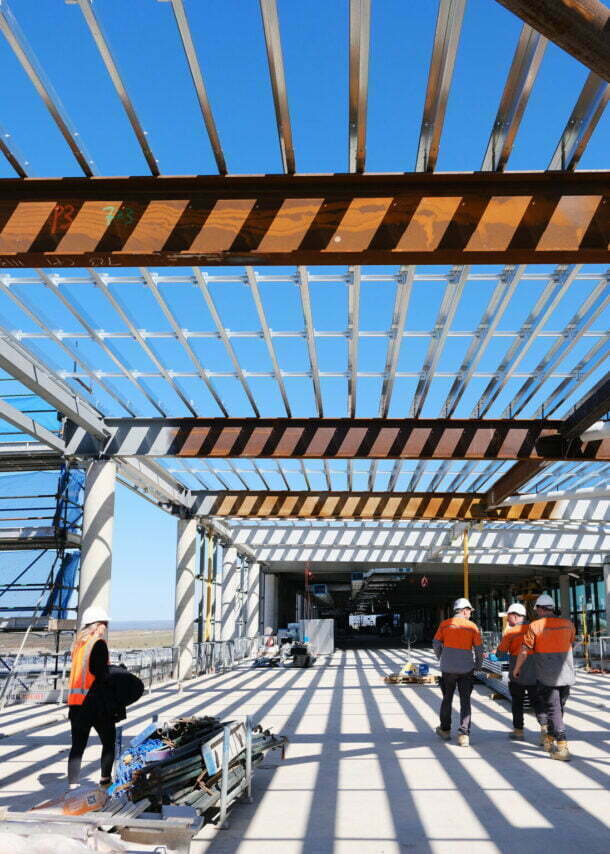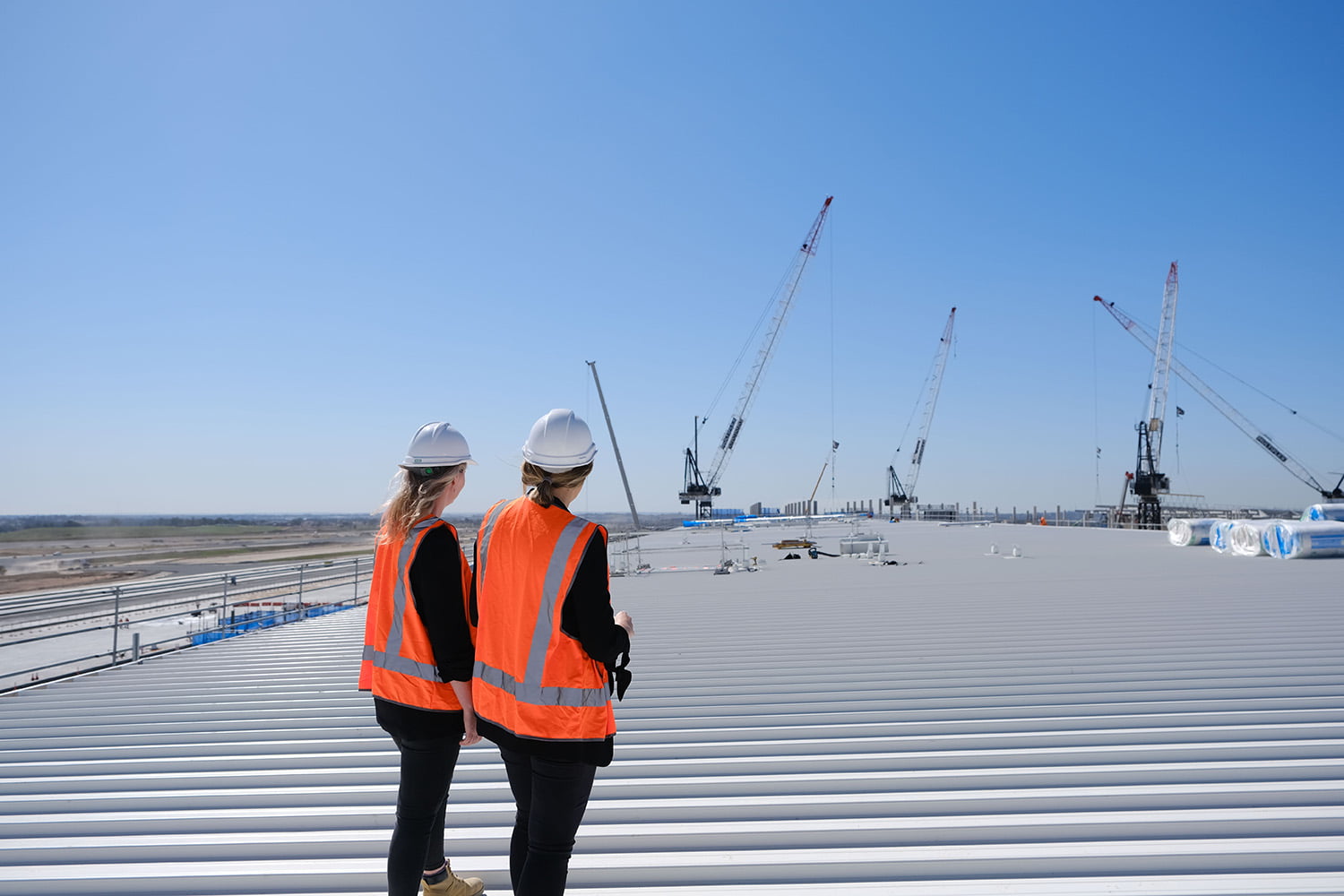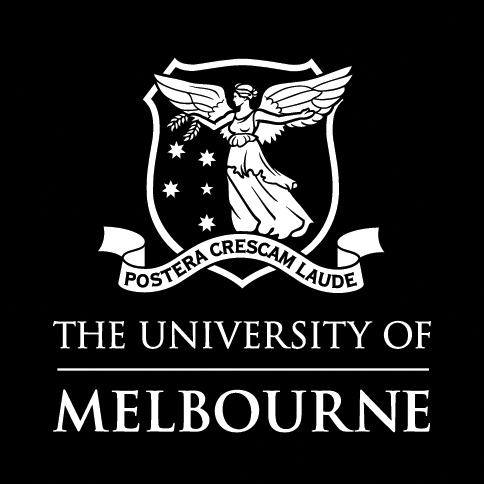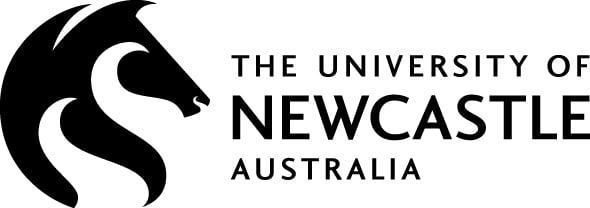Ashlea Jenkins and Alice Cook are joint project leaders on Woods Bagot’s Western Sydney International Airport, a $5.3 billion project and one of the largest infrastructure projects in progress in Australia. They are also both new mothers. Isla Sutherland interviews Alice and Ashlea about how they make their job share arrangement work.

There remains a significant gap between the proportion of female graduates and those represented in formal leadership roles. This can be attributed to unconscious bias, the lack of flexibility in traditional practice, and the disproportionate burden that raising a family places on women, among other things.
While family remains one of the main barriers to women attaining architectural leadership roles, Ashlea Jenkins and Alice Cook are two women who have managed to break through, job-sharing on one of Woods Bagot’s most significant transport projects.
Ashlea joined the Western Sydney Airport project in February 2022 after returning from maternity leave following the birth of her son. “Nothing prepared me for parenthood,” she says. “I’m always up for a challenge, whatever that looks like – but this is something you can’t understand until you’re in it.”
Your organisation scores really ramp up when you’re running a project and running a family.You have to take each day as it comes – you learn to be more level-headed and not get so caught up in the chaos. You don’t get too fixated on things that don’t matter.”
Mother-of-two and project leader Alice Cook
Job sharing
Job-sharing in senior leadership is becoming more common, enabling hands-on parents to take on greater responsibility in the workforce. Flexible working arrangements are much more the norm, with shifting attitudes for flexible working and parental leave policies creating more opportunities for women in leadership positions. For Alice and Ashlea, it has enabled them to run a multi-billion-dollar project alongside starting their families.
Job sharing with someone with similar life circumstances and challenges can help to ensure the success of the working arrangement. Ashlea explains that the support and understanding she receives from her counterpart has been key to the project’s success and her own ability to manage her responsibilities at home and in practice.
“Alice and I have great trust and we laugh a lot, but both being mums really helps – there is that understanding for what the other is going through,” she says. “I’d like to think that before I was a mum I could understand it, but I don’t think I did until I’d experienced it myself. When you have demands in your life outside of work, it’s nice to have another parent in that role as well.”
“I don’t think it would be possible to achieve a project at this scale and this intensity if you didn’t have someone else to balance out the work – not just that, but someone you really get along with,” adds Alice. “This was our first time working together, and both as new mums. We really offer support to one another.”


Making it work
Ashlea and Alice say the success of their relationship lies in effective communication and an ability to adapt to circumstances as they arise.
“We have our own scope that we deal with, but we’re always across what the other is doing,” says Ashlea. “There’s not a formal handover – we’re across all deliverables together. But we’re good communicators and would download to each other almost every day.”
“We try to be in the office the same days, which might be two or three days a week, and will overlap our days onsite,” says Alice. “There is no formality or rigidity to it, and the flexibility to be fluid and adaptable really helps.”
As for their suggestion to companies who might be reticent about offering flexible models of leadership, they say it’s all down to the right pairing of personalities and experience.
It’s about complementing each other and being genuinely invested in the success of your counterpart. It relies on openness and trust, and serious support from the leaders above you. It’s important you feel a sense of ownership and responsibility over the project, but also the confidence that you’ll be heard if it gets too much.”
Ashlea Jenkins

Role models
Alice says that visibility is one of the key factors to drive change, with different types of role models and new possibilities appealing to a broader swathe of people. As the old maxim goes, you can’t be what you can’t see.
“By having parents in the office with kids that get sick and need to take time off, it actually gives people permission, even those without children, to realise that life happens. Work isn’t the only thing,” Alice adds.
“I think the impacts of COVID and the introduction of hybrid working arrangements have been the biggest things to removing barriers for women, particularly mothers,” Alice continues. “It’s the ability to always be close to work as you need, whether the kids are sick or if you need to log in after hours.”
Challenges
Change doesn’t come without its challenges, however, and the battle for equal representation remains an uphill one. Despite the increasing acceptance of flexibility in the workplace, there persists a gruelling after-hours culture, which creates difficulties for parents playing an active role in child-rearing.
“At Woods Bagot, having a child wasn’t seen as something that was going to hold me back,” says Ashlea. “That is a positive, but in turn, it’s for me as an individual to accept the pressure in my life for the benefit of my career.
“For me, it always comes back to my son,” she continues. “I’ll ask myself: is there a point where I’m not being the best mum I can be for him? And I haven’t reached that point yet.”
“There are sacrifices, of course – sleep, being the main one,” Alice agrees. “But at the end of the day, it’s important for me to have an active mind and stay in touch with the industry. And I’ll never get another opportunity like this – that’s what really keeps me going.”

Working parents
Alice adds that an appreciation for young women and mothers in the industry is steadily growing thanks to an acknowledgement of different types of skills and abilities – emotional intelligence, effective communication, managing priorities, pre-emptive problem-solving capabilities and negotiation skills.
“There used to be a stigma that working mothers couldn’t be as committed to their roles, but now, these mums are machines: they’re organised, they get their jobs done efficiently, even with the demands of parenthood,” says Alice. “There’s a real respect among our project team – an acknowledgement that we are young mothers, and that doesn’t need to change the role we can do.”
The need for change
Ashlea feels that despite a supportive workplace and changing attitudes towards women in leadership, the industry is in desperate need of an overhaul to make the culture more accommodating of people with competing demands.
“Within the broader architecture community, the hours we do can be unsustainable. We all need to look after ourselves, and some of us have to look after little people as well. I would hope that more parents in leadership roles could change [the culture], but I think we need to look at it as an industry first.”
As for her advice to other young women considering juggling parenthood and a career, Alice says, “Don’t think about it too much”.
“There’ll always be an excuse not to do it. Before I had children, I never believed I could come back to work. But once I got going, I started to carve my own path and find a rhythm that worked for me and my team,” says Alice.
For Ashlea, it’s about being honest with yourself about what you can handle and not being afraid to ask for help.
Someone once asked me, ‘What’s it like to have it all?’ And I said, ‘Define all.’ You have to work out what you want as a parent and as a professional. Be really honest with yourself about what that looks like and what you’re prepared to sacrifice. Because it’s hard work doing both. You need to look in the mirror and define your ‘all’, and have the confidence to put your hand up and say when it’s too much.”
Ashlea Jenkins

Western Sydney Airport will be named after Nancy Bird Walton – mother-of-two and pioneering Australian aviator known as the “Angel of the Outback”, and founder of the Australian Women Pilots’ Association. The airport will begin international and domestic passenger services and air cargo flights in late 2026.
Zaha Hadid Architects and Cox Architecture won an international competition for the concept design of the Western Sydney International Airport in 2019, which served as the reference design in the tender for a contractor. The project has since been developed and delivered by Woods Bagot.
Ashlea Jenkins is a Senior Associate at Woods Bagot Sydney with over 10 years’ experience across interiors, aged care, commercial and transport sectors. Alice Cook is a Sydney-based architect and Woods Bagot Senior Associate with 15 years’ experience across commercial and transport sectors. Both Ashlea and Alice are currently project leaders on the Western Sydney International Airport.
Isla Sutherland is the content and communications specialist at Woods Bagot.




















